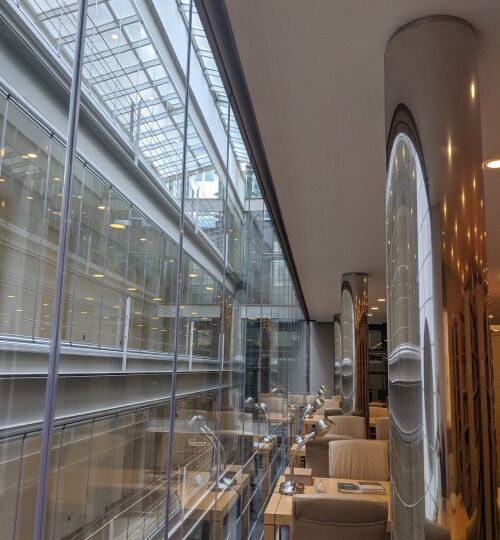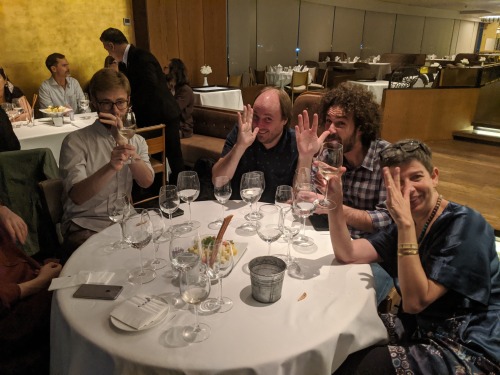
The way I most often find myself describing ANAMED to others is as a “scholarly monastery.”
This is, of course, because of its physical form; fellows live in their individual cells (much more luxurious than standard monastic quarters), moving between different parts of the building to prepare food, work in the library, partake in shared beverages, or come together to interact in personal and professional contexts. Opening one’s door to look through large glass panes onto a library is a constant reminder of scholarly duties, but also of the pieces of our lives that all fellows share. ANAMED’s characterization as something of a monastery, however, also captures the sense of community and belonging that is—or can be—quickly engendered in such all-encompassing shared spaces. I cannot speak for my colleagues who spend their days considering historic monastic life, but daily life in and around the Merkez Han frequently has me thinking about my own work. As an archaeologist, my main research focus is identity and the dynamics of ancient communities. This is particularly salient for our understanding of (ancient) cross-cultural interaction in trading settlements, colonies, and within the general context of ubiquitous Mediterranean and Anatolian mobility, all of which would have brought together a diverse array of people living in longer-term, close proximity. ANAMED fellows’ collective diversity, our interactions, and our individual practices all offer the chance to consider—and constantly reconsider—the social experience of those ancient interactions for individual people participating in them.
How does this work? In my own work, I’ve argued that a specific definition and framework make communities not only possible subjects for study in the archaeological record, but also comparable—in terms of understanding how they form and change—across contexts that are very different in time and space.[1] When different people come together in new spaces, in order to understand what aspects of their own practices and identity are of greater or lesser importance (i.e., the things they maintain), and what aspects of their daily lives they find commonality in to identify with new neighbors (i.e., things they’re willing to change), I’ve argued that it’s helpful to look at three categories of evidence: shared maintenance practices, shared ritual practices, and shared social experiences. Instead of a lengthy, theoretical explanation of all of this, I’ll dive straight into how it plays out within the ANAMED community of fellows.
When a new crop of fellows arrives each September, we know little about one another except that we share two basic things in common. We’re all academics and researchers, and we’re all focused on something that relates in some fashion to Anatolia. Though our focus and methodology might be different—archaeology, history, philology, philosophy—and our evidence therefore looks quite different, too, we nonetheless share similar practices and experiences. After all, common across the humanities (and other fields) are the processes of formulating research questions, interrogating and evaluating evidence, spending hours (or weeks) hunting down important sources, writing as a means of thinking and communicating, and considering aspects of the intention and experience that belonged to people who have, in many cases, been quite dead for a significant period of time.
The fellows share other “maintenance practices” too, however, and by that, I mean the kinds of things that are required to sustain life, either physically or, in the case of fellows-as-scholars, professionally: we’re provided with accommodations, but need to seek out or prepare food, need to acquire basic necessities, and have to take care of some vices to which we’re personally accustomed (e.g., coffee! cigarettes! wine!). There are only so many ways to go about such things in and around the Merkez Han, and yet it’s interesting to see both how differently some people approach them, and how interested they generally are in how others have chosen to do so. For example, some fellows have taken to preparing meals in the shared kitchen, and knowledge of where to purchase particular ingredients and what can be most easily prepared with the tools at hand is coveted. A little creativity goes a long way, and people are happy—and indeed enthusiastic—to share their “go-to” staples and increase everyone’s repertoire of healthy, inexpensive eats. (For the record, I’m a fan of doctoring a packet of tavuk çorbası with some added orzo, lemon, and tempered eggs, for a tasty faux-avgolemono.) Newly discovered restaurants are also a hot commodity, either for their novelty, their quality, their price point, or (ideally) all three. Finding and sharing “solutions” that fulfill our collective needs in interesting ways is one of the primary things that seems, at least socially, to literally bring people together.

Members of the ANAMED community of fellows partake in an educational wine tasting, brought together by shared interest in Anatolian grapes
These shared practices bleed seamlessly into shared social experiences—more intangible aspects of communal living that are attested quite obliquely by material culture, at least in ancient contexts. Eating together in the same restaurants, fighting to walk through Istiklal’s throngs on busy evenings and weekends, attending Friday teas, coordinating use of the washing machines, sitting in the same library spaces, making efforts to personalize living space, and, of course, trying to sleep through the dulcet tones of ‘90s and early ‘00s Turkish pop that emanate from our night-club-neighbor every day between 10:45pm and 12:45am… these are all augmented by shared social experiences that are not inherent to life at ANAMED, but in which we choose to participate together… going farther afield to try new restaurants, socializing on the terrace, exploring new neighborhoods in the city, and hunting down local concerts. These extend beyond the positive to include more stressful experiences: worrying over socio-political climates in our home countries, concern over the welfare of others, of the planet, and strategies for addressing all of those; supporting one another through the trials and tribulations of the academic job market, of early-career research challenges, and the general stresses that come with regular and repeated academic nomadism (at least for some of us).
What helps all of these aspects of our lives to engender a sense of community is that they are shared. Both those creative and productive solutions to problems or needs we all face, but also more embodied knowledge and practice. The knitters and crocheters of ANAMED, for example, meet irregularly, but enthusiastically, to drink hot beverages, eat snacks, and engage socially in creating. Having all been taught different crafts in different places, it’s still possible to come together and explore the differences and similarities in our practices… both terminology and technique. The same is true for cooking. Until I came to ANAMED, I was completely unaware that Serbian strudel is an entirely different (and equally delicious) animal than its Austro-German counterpart. And yet, fellows are both enthusiastic to share their own ways of doing and genuinely interested in exploring others’.

ANAMED fellow Bianca D’Anna shows off her scarf, the first completed project for the terrace yarn club
Above all else, what has been thought-provoking about being part of a developing ANAMED community has been this question of curiosity. When we think about the ancient world, the default notion about cross-cultural interaction is that people needed some kind of impetus to make it happen, or that they would have been generally suspicious of the “other.” The idea that merchants and their families coming together in a new, permanent home on some piece of Mediterranean coastline would have been genuinely open to, and curious about, their new neighbors’ practices isn’t often openly discussed. That they might have selectively adopted goods or practices they liked, yes, but not that pure curiosity might have been the cause, or that people might have tried out something new for its own sake, like preparing grains in a different pot, or stewing their meat instead of grilling it. People are creative, and they’re curious. Fundamentally, we are interested in getting to know others, and in understanding what they do and why. It’s true that, in the development of a new communal identity—a sense of shared belonging to something—it is necessary to have a spark of sorts, or an initial shared thing. The fellows certainly have more than just our residence in the Merkez Han, but perhaps the necessity of living together in a new, shared space, and finding creative solutions for daily necessities would have been enough in the ancient world as well.

The author receives training in the tradition of cooking-decorating for St. Martin
[1] For the interested reader, I use the following base definition of communities from Canuto and Yaeger’s 2000 The Archaeology of Communities. A New World Perspective: Community is “an ever-emergent social institution that generates and is generated by suprahousehold interactions that are structured and synchronized by a set of places within a particular span of time. Daily interactions rely on and, in turn, develop shared premises or understandings, which can be mobilized in the development of common community identities” (5).

